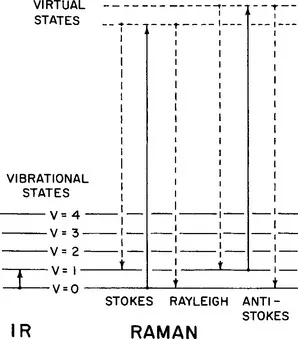
The Handbook of Infrared and Raman Characteristic Frequencies of Organic Molecules
- 503 pages
- English
- ePUB (mobile friendly)
- Available on iOS & Android
The Handbook of Infrared and Raman Characteristic Frequencies of Organic Molecules
About this book
This necessary desk reference for every practicing spectroscopist represents the first definitive book written specifically to integrate knowledge about group frequencies in infrared as well as Raman spectra. In the spirit of previous classics developed by Bellamy and others, this volume has expanded its scope and updated its coverage. In addition to detailing characteristic group frequencies of compounds from a comprehensive assortment of categories, the book includes a collection of spectra and a literature search conducted to verify existing correlations and to determine ways to enhance correlations between vibrational frequencies and molecular structure. Particular attention has been given to the correlation between Raman characteristic frequencies and molecular structure.- Constitutes a necessary reference for every practicing vibrational spectroscopist- Provides the new definitive text on characteristic frequencies of organic molecules- Incorporates group frequencies for both infrared and Raman spectra- Details the characteristic IR and Raman frequencies of compounds in more than twenty major categories- Includes an extensive collection of spectra- Compiled by internationally recognized experts
Frequently asked questions
- Essential is ideal for learners and professionals who enjoy exploring a wide range of subjects. Access the Essential Library with 800,000+ trusted titles and best-sellers across business, personal growth, and the humanities. Includes unlimited reading time and Standard Read Aloud voice.
- Complete: Perfect for advanced learners and researchers needing full, unrestricted access. Unlock 1.4M+ books across hundreds of subjects, including academic and specialized titles. The Complete Plan also includes advanced features like Premium Read Aloud and Research Assistant.
Please note we cannot support devices running on iOS 13 and Android 7 or earlier. Learn more about using the app.
Information
Introduction
Publisher Summary
1-1 PRINCIPLES AND SELECTION RULES
1-1.1 Infrared Spectroscopy




1-1.2 Raman Spectroscopy



1-1.3 Selection Rules
Table of contents
- Cover image
- Title page
- Table of Contents
- Copyright
- Dedication
- PUDDLE
- Preface
- Acknowledgment
- Chapter 1: Introduction
- Chapter 2: Alkanes
- Chapter 3: Halocompounds
- Chapter 4: Alcohols and Phenols
- Chapter 5: Ethers and Peroxides
- Chapter 6: Alkenes
- Chapter 7: Acetylenes
- Chapter 8: The –C≡N and –N≡C Groups
- Chapter 9: Compounds Containing the Carbonyl Group
- Chapter 10: Compounds Containing –NH2, –NHR, and –NR2 Groups
- Chapter 11: The Nitro Group
- Chapter 12: Double Bonds Containing Nitrogen Atoms
- Chapter 13: Cumulated Double Bonds
- Chapter 14: Organic Sulfur Compounds
- Chapter 15: Organosilicon Compounds
- Chapter 16: Organophosphorus Compounds
- Chapter 17: Aromatic and Heteroaromatic Rings
- Chapter 18: Selected Infrared and Raman Spectra from the Sadtler Research Laboratories, Division of Bio-Rad Laboratories, Inc. for Compounds with Structures Discussed in Chapters 2–17
- Appendix 1: Infrared and Raman Spectra of Common Organic Compounds—From the Aldrich Library of FT-IR Spectra and the Dollish, Fateley and Bentley Collection
- Appendix 2: Infrared and Raman Spectra of Selected Carbohydrate, Steroid, Organometallic, and Polymer Spectra from the Schrader Raman/Infrared Atlas of Organic Compounds
- Appendix 3: A Summary of Characteristic Raman and Infrared Frequencies
- Alphabetical Name Index of Spectra
- Molecular Formula Index of Spectra
- Index